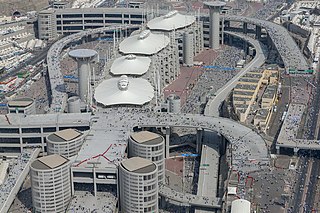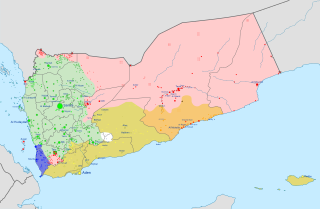
Mecca is the capital of Mecca Province in the Hejaz region of western Saudi Arabia; it is the holiest city according to Islam. It is 70 km (43 mi) inland from Jeddah on the Red Sea, in a narrow valley 277 m (909 ft) above sea level. Its metropolitan population in 2022 was 2.4 million, making it the third-most populated city in Saudi Arabia after Riyadh and Jeddah. Around 44.5% of the population are Saudi citizens and around 55.5% are Muslim foreigners from other countries. Pilgrims more than triple the population number every year during the Ḥajj pilgrimage, observed in the twelfth Hijri month of Dhūl-Ḥijjah. With over 10.8 million international visitors in 2023, Mecca was one of the ten most visited cities in the world.

Medina, officially Al-Madinah al-Munawwarah and also commonly simplified as Madīnah or Madinah and known in pre-Islamic times as Yathrib (يَثْرِب), is the capital of Medina Province in the Hejaz region of western Saudi Arabia. It is one of the oldest and most important places in Islamic history. One of the most sacred cities in Islam, the population as of 2022 is 1,411,599, making it the fourth-most populous city in the country. Around 58.5% of the population are Saudi citizens and 41.5% are foreigners. Located at the core of the Medina Province in the western reaches of the country, the city is distributed over 589 km2 (227 sq mi), of which 293 km2 (113 sq mi) constitutes the city's urban area, while the rest is occupied by the Hejaz Mountains, empty valleys, agricultural spaces and older dormant volcanoes.

On 31 July 1987, during the Hajj in Mecca, a clash between Shia pilgrim demonstrators and the Saudi Arabian security forces resulted in the death of more than 400 people. The event has been variously described as a "riot" or a "massacre". It developed from increasing tensions between Shia Iran and Sunni Saudi Arabia since the 1979 Iranian Revolution. Since 1981, Iranian pilgrims have held a political demonstration against Israel and the United States every year at Hajj, but in 1987, a cordon of Saudi police and the Saudi Arabian National Guard sealed part of the planned demonstration route, resulting in a confrontation between them and the pilgrims. This escalated into a violent clash, followed by a deadly stampede.

There have been numerous incidents during the Hajj, the Muslim pilgrimage to the cities of Mecca and Medina, that have caused loss of life. Every follower of Islam is required to perform the Hajj in Mecca at least once in their lifetime, if able to do so; according to Islam, the pilgrimage is one of the Five Pillars of Islam. During the month of the Hajj, Mecca must cope with as many as three million pilgrims.

The Jamaraat Bridge is a pedestrian bridge in Mina, Saudi Arabia, near Makkah used by Muslims during the Hajj ritual Stoning of the Devil. The purpose of the bridge is to enable pilgrims to throw stones at the three jamrah pillars either from the ground level or from the bridge. Jamaraat is the plural of jamraah, the Arabic term for each of the pillars involved in the stoning ritual. It literally means a small piece of stone or a pebble.

The destruction of heritage sites associated with early Islam is an ongoing phenomenon that has occurred mainly in the Hejaz region of western Saudi Arabia, particularly around the two holiest cities of Islam, Mecca and Medina. The demolition has focused on mosques, burial sites, homes and historical locations associated with the Islamic prophet Muhammad, his companions, and many of the founding personalities of early Islamic history by the Saudi government. In Saudi Arabia, many of the demolitions have officially been part of the continued expansion of the Masjid al-Haram at Mecca and the Prophet's Mosque in Medina and their auxiliary service facilities in order to accommodate the ever-increasing number of Muslims performing the pilgrimage (hajj).
The Saudi government does not conduct a census on religion or ethnicity, but some sources estimate the Shia population in Saudi Arabia to make up around 10-15% of the approximately 34 million natives of Saudi Arabia.

Islam is the state religion of Saudi Arabia. As the "home of Islam" where the prophet of Islam lived and carried out his mission, the kingdom attracts millions of Muslim Hajj pilgrims annually, and thousands of clerics and students who come from across the Muslim world to study. Approximately 100% of its citizens are Muslim and most of its large population of foreign workers are as well. Hanbali is the official version of Sunni Islam and it is used in the legal and education systems. The Basic Law of Saudi Arabia states that it is the duty of every citizen to defend Islam.

Hajj is an annual Islamic pilgrimage to Mecca, Saudi Arabia, the holiest city for Muslims. Hajj is a mandatory religious duty for capable Muslims that must be carried out at least once in their lifetime by all adult Muslims who are physically and financially capable of undertaking the journey, and of supporting their family during their absence from home.

The Mecca fire of 1997 was a fire that occurred in the tent city Mina near Mecca in Saudi Arabia 15 April 1997, killing between 217 and 300 people and injured 1,300. According to witnesses, most of the dead were from India, Pakistan and Bangladesh.
The following lists events in 2014 in Saudi Arabia.

On 26 March 2015, Saudi Arabia, leading a coalition of nine countries from West Asia and North Africa, launched a military intervention in Yemen at the request of Yemeni president Abdrabbuh Mansur Hadi, who had been ousted from the capital, Sanaa, in September 2014 by Houthi insurgents during the Yemeni Civil War. Efforts by the United Nations to facilitate a power sharing arrangement under a new transitional government collapsed, leading to escalating conflict between government forces, Houthi rebels, and other armed groups, which culminated in Hadi fleeing to Saudi Arabia shortly before it began military operations in the country.

A crawler crane collapsed over the Masjid al-Haram in Mecca, Saudi Arabia, around 5:10 p.m. on 11 September 2015, killing 111 people and injuring 394 others. The city was preparing for the Hajj pilgrimage. The collapse has been cited as the deadliest crane collapse in history, with the previous most deadly incident being the collapse of a construction crane in New York City in 2008, killing seven people.

On 24 September 2015, a fatal crowd crush resulted in the death of more than 2,000 individuals, many of whom were suffocated or crushed, during the annual Hajj pilgrimage in Mina, Mecca, Saudi Arabia, making it the deadliest Hajj disaster in history. Estimates of the number of dead vary: the Associated Press reported 2,411 dead, while Agence France-Presse reported 2,236 killed. Based on the total of the individual national reports cited in the table below, at least 2,431 lives were claimed. The government of Saudi Arabia officially reported two days after the event that there had been 769 deaths and 934 injured. These figures remained official at the time of the next year's Hajj and were never updated. The largest number of victims were from Iran, followed by Mali and Nigeria.
The following lists events in the year 2017 in Saudi Arabia.

The COVID-19 pandemic affected the 2020 Hajj (pilgrimage), which is the fifth pillar of the Five Pillars of Islam, where millions of Muslims from around the world visit Mecca and Medina every year during Hajj season for a week. Over 2,400,000 pilgrims attended Hajj in 2019. Due to the highly contagious nature of COVID-19 in crowded places, various international travel restrictions, and social distancing recommendations, the Ministry of Hajj and Umrah advised Muslims to postpone their pilgrimage until the pandemic was mitigated. However, in June 2020, the Ministry opened up Hajj to people of all nationalities residing in Saudi Arabia, with foreigners still banned from attending to ensure pilgrims' safety and prevent the transmission of COVID-19.
Events in the year 2023 in Saudi Arabia.

On 28 March 2023, a bus carrying Umrah pilgrims crashed into a bridge in Asir province, southwest of Saudi Arabia, resulting in the death of at least 20 pilgrims and 29 others being injured. The victims were en route to Mecca to perform Umrah during the first week of Ramadan. The accident was caused by a brake failure, which caused the bus to overturn and catch fire. The Saudi civil defense and Red Crescent Authority teams immediately responded to the scene of the accident and cordoned off the area. The injured and deceased were transported to nearby hospitals. The victims were reported to be of different nationalities.














